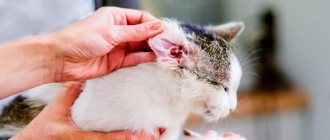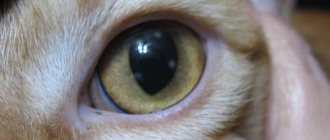Domestic cats and dogs have a similar reproductive system. In cats, the reproductive organs are represented by the uterus, which has two horns, ovaries, fallopian tubes and vagina.
The occurrence of spotting or blood from the loop area in a cat is a cause for concern. Diseases in the renal system can also cause bleeding in a pet.
Some owners are not alarmed when they notice bloody discharge from a cat’s snare, believing that this is the period of sexual heat. But unlike dogs, during estrus a cat should not produce bloody exudate from the vagina.
Physiologically caused bloody discharge in cats are those that appear in the period before the onset of the birth process and several weeks after.
Otherwise, if the owner notices blood on the litter or on the cat’s genitals, it is necessary to contact a veterinary clinic for help. At home, it is not possible to determine the exact cause of the appearance of blood. Any delay can cause the death of the cat.
How dangerous is this?
Many owners believe that spotting in cats occurs due to pathologies of the urinary system. Indeed, the symptom may indicate inflammation or the formation of stones. Such diseases often lead to death. Therefore, if illness appears, it is important to show the animal to a veterinarian as quickly as possible. Often, spotting in cats occurs due to an improper diet.
A lack of iron and other important substances in food negatively affects the pet’s well-being, leading to deterioration and metabolic disorders. However, there are cases when such a symptom is the result of natural changes occurring in the animal's body. But this does not mean that you need to independently draw conclusions about the reason for its appearance. To establish the correct diagnosis, you must consult a veterinarian.
What to do
Abnormal bleeding like the ones described can be very alarming, but remember to remain calm. Just be aware that if this happens, contact your veterinarian immediately because different treatments will be needed depending on the cause. Additionally, some diseases that cause bleeding can be fatal if not treated promptly.
Also remember that you should never self-medicate your cat or ignore his symptoms of illness or discomfort.
This article is for informational purposes only; we cannot prescribe veterinary treatment or make any diagnosis on the site. We recommend that you take your pet to the vet if he has any problems or discomfort.
Normal changes that occur in the body
In some cases, bloody discharge is observed in a cat for reasons related to natural processes. Such circumstances do not pose a threat to the health of the animal. Such changes include the following:
- Estrus. This process is accompanied by an increase in the pet’s activity. The female often arches her back, rolls around on the floor, and becomes playful. It is absolutely normal for a cat to have bloody discharge during estrus. After this period ends (as a rule, this happens after a few days), the symptom disappears completely.
- Bearing offspring. The presence of this sign in a pregnant female indicates a restructuring of the body and preparation for the birth of cubs. However, intense discharge indicates the development of serious pathological processes.
Physiological causes of blood in urine
The very presence of blood in urine is called hematuria in medicine. It is considered normal after bladder catheterization, cystoscopy or surgical interventions on the abdominal organs. This primarily concerns operations to remove prostate adenoma in men, when the instrument is inserted through the urethra.
Physiological reasons also include:
- hypothermia or overheating;
- heavy physical activity;
- toxic infections (flu, rubella, tonsillitis, bronchopneumonia, etc.);
- taking the antibiotic penicillin or the anticancer drug cyclophosphomide.
If none of the above happened to you, then the causes of traces of blood in the urine may be associated with diseases that require medical attention. The pathological nature of the symptom is indicated by the presence of other symptoms:
- frequent urge to urinate;
- mucopurulent discharge from the urethra;
- difficulty urinating;
- increased body temperature;
- pain in the lower abdomen.
Dangerous diseases
There are situations when bleeding indicates serious illness. This symptom should not be ignored, as it can manifest itself under the influence of the following circumstances:
- The process of decomposition of the placenta. After giving birth, a cat's bloody discharge, which has a liquid consistency, indicates that the remains of the placenta have not left the animal's body. Most likely, the pet will require surgical intervention.
- Infectious processes occurring in the genitals. Thick light red discharge often occurs in females with pathologies of the urinary system and uterus.
- Malignant neoplasms. The leakage of blood and pus is a characteristic sign of cancerous tumors of the reproductive system. As a rule, with this pathology, the discharge has an unpleasant odor.
- Inflammatory processes occurring in the genitals, for example, in the vagina. Such diseases are accompanied by difficulty urinating, aggression and anxiety. The cat often licks the lower part of its body. This symptom indicates that the animal is feeling severe discomfort.
Bleeding due to vaginitis
The disease is an inflammatory process in the vaginal area. A female with a similar pathology attracts males. Therefore, many owners confuse vaginitis with estrus. In cats, bleeding with this disease is accompanied by frequent licking of the perineum and restlessness. If you suspect this disease, you should show the animal to a specialist as soon as possible.
A complication of vaginitis can be an inflammatory process in the bladder, pyometra and pathology of the inner layer of the uterus.
Discharge from endometritis
This disease can have both an acute and chronic course. The second form of the disease does not affect the pet’s well-being. The cat mates with males, but in most cases pregnancy does not occur. If fertilization does occur, the cubs often die in the womb or almost immediately after birth. An acute inflammatory process in the inner mucous membrane of the uterus is a serious illness. Bloody discharge in cats with this pathology is accompanied by loss of appetite and general weakness. If you do not provide medical assistance to the animal in time, it may die.
How to determine the onset of ovulation?
The time period when ovulation is most likely is called the ovulatory period.
Knowing what happens during ovulation, many women claim that they feel its external signs - for example, pain, which is associated with rupture of the follicle. However, it is impossible to confirm this relationship with a 100% guarantee. It is better to use other methods (given to increase the accuracy of the result).
- Menstruation calendar (and a more convenient version - special applications for smartphones)
The method is suitable for women with regular cycles. If the cycle length is 28 days, then ovulation occurs approximately on the 14th day after the start of menstruation. If the cycle is shorter or longer, then the time of ovulation must be calculated using a special formula.
- Basal temperature
During the ovulatory period it reaches 37 °C. However, keep in mind that elevated temperature can be a sign not only of ovulation, but also of inflammatory processes.
- Ovulation tests
They are similar to pregnancy tests and respond to changes in luteinizing hormone levels.
- Ultrasound
An ultrasound shows how the follicle increases in size. When signing up for an ultrasound, you need to clarify that you plan to find out exactly the period of ovulation; in this case, they will not perform an ultrasound of all pelvic organs, and the procedure itself will cost less.
This method is considered the most accurate, but it is not always convenient: to calculate the release date of the egg, you will have to visit the ultrasound room 3 or even 4 times per cycle. In some cases, ultrasound is performed daily.
If fertilization does not occur, the egg dies. After 2 weeks, the endometrium (this is the mucous membrane - a fertilized egg should be attached to it) is separated and removed from the body, that is, menstruation begins.
Ovulation occurs up to 12 times a year. Why then do some women fail to conceive a child for years? The cause may be various deviations in the ovulation process.
Symptom during pregnancy and after childbirth
Excessive bleeding in cats during pregnancy, which is bright red or light in color and lasts more than 10 minutes, indicates damage to the uterus. In this case, you need to contact a specialist as soon as possible. Also, the appearance of brown liquid at 8-9 weeks of gestation should not be ignored.
The animal should be shown to a doctor. Laboratory tests are performed at the clinic. The veterinarian performs an ultrasound examination for the presence of dead fetuses and makes a decision about therapy.
Such a phenomenon does not always mean the presence of pathology. For example, after fertilization, you may notice pink fluid flowing from the animal's genital tract. Before the birth process begins, the discharge of dark blood is also considered quite normal. This symptom cannot be ignored when the kittens have already been born.
In this situation, it may indicate mechanical damage to the uterine tissue. Injuries often occur during the delivery process. To eliminate this problem, drugs that stop bleeding are used. In severe cases, surgical intervention is necessary. Sometimes a female who has recently given birth becomes infected in her genitals as a result of violation of sanitation rules. In this case, the cat experiences bleeding and pus. To prevent infection, it is important to keep the area where the mother and her babies are kept clean.
Diagnosis and treatment
Before starting treatment, the veterinarian determines the cause of uterine bleeding. It is not possible to stop bleeding without identifying the underlying factor.
If a cat owner notices signs in their pet that indicate the development of pathology, it is necessary to take the animal to the clinic as soon as possible.
In addition to a general clinical examination, the doctor will prescribe a number of diagnostic measures. To make an accurate diagnosis, the following types of studies are necessary:
- ultrasound examination of organs located in the abdominal cavity;
- X-ray of the pelvic organs;
- smear and cytological examination of discharge;
- taking samples of biological material from the vagina;
- general clinical blood test;
- Analysis of urine;
- bacterial culture on nutrient media to determine the type of pathogenic microorganisms.
The degree of damage to the uterine walls will serve as the basis for developing treatment tactics. For minor injuries, characterized by not extensive hemorrhage, cauterization of the burst vessels is carried out using a coagulator.
It is important to use a coagulator for ruptures of blood vessels located in the cervical area. Extensive hemorrhages require surgical manipulation to remove the bleeding organ.
During the surgical intervention, not only the uterus, but also the appendages are removed, preventing the development of complications in the future. It is recommended to completely remove the female reproductive organs if malignant neoplasms are diagnosed.
Conservative therapy consists of the use of antishock drugs. A course of antibiotics is also prescribed, necessary to destroy pathogenic microflora that causes suppuration.
If a cat has lost a large amount of blood as a result of uterine bleeding, a blood transfusion is recommended. At the same time, medications are administered to normalize the functioning of blood clotting factors.
Diagnosed malignant tumors are surgically removed and further chemotherapy is prescribed to reduce the risks of complications and possible relapses of the disease.
Treatment is prescribed exclusively by a veterinarian. The cat owner must follow all instructions and not self-medicate, including adjusting drug dosages without notifying the veterinarian. Otherwise, this may lead to the death of the animal.
Symptoms appear after sterilization
Typically, such an operation assumes the absence of estrus. However, spotting and sexual activity in a sterilized cat are sometimes observed, which indicates the following conditions:
- Neoplasms in the adrenal or mammary glands.
- The presence of cysts in the uterine area.
- Gradual cessation of hormone activity. These substances may remain in the animal’s blood for some time after surgery. As a rule, after 8 weeks this period ends.
- The presence of gonadal tissue cells in other organs.
What happens to a woman's body during ovulation?
From birth, a girl’s body contains germ cells – eggs. They are found in the ovaries, with each egg enclosed in a small sac called a follicle.
At the beginning of each cycle, follicle-stimulating hormone begins to be produced, which gives a signal to the process of follicle maturation. In the period preceding ovulation, the follicle gradually becomes larger and actively secretes estrogens, and at this time the egg matures in it. Estrogens, in turn, cause the synthesis of luteinizing hormone.
When the concentration of luteinizing hormone exceeds a certain level, the follicle bursts, releasing an egg that is ready for fertilization. The egg moves into the fallopian tubes, where it can meet the sperm. To make it easier for sperm to reach the fallopian tubes, the acidity of the vagina changes, which can be noticed by a change in the nature of the discharge.
The egg leaves the follicle within an hour and remains ready for fertilization throughout the day. Spermatozoa are ready for it within 3-5 days after entering the woman’s genital tract. This allows you to calculate the period when the chances of getting pregnant are highest: 2-3 days before ovulation, immediately on the day of ovulation and another day after it. This is very important for partners who want to become parents, since it is almost impossible to determine ovulation externally.
Presence of stones in the urinary system
This pathology is often found among domestic animals.
Most often it affects males. However, sometimes stones in the organs of the urinary system are found in females. The exact reasons for the formation of stones have not yet been identified. However, experts say that abuse of dry food, deficiency of vitamin A and fluid in the diet, excess weight, gastrointestinal diseases and poor heredity can provoke the disease. Stones are one possible explanation for why your cat is bleeding.
Why doesn't ovulation occur?
- To begin with, it should be clarified that it does not occur in every cycle, which means that conception may not occur in any month.
- Under the influence of external factors (stress, medication), the cycle changes duration, that is, the time of ovulation shifts.
- The cause of the failure may be a disease of the reproductive system - for example, polycystic ovary syndrome. In this case, ovulation either occurs irregularly or is completely absent.
- Hormonal disruptions also lead to disturbances: for example, due to stress, the level of the hormone prolactin increases, which suppresses the synthesis of hormones necessary for the release of the egg from the follicles.
If tests show irregular ovulation or a cycle without ovulation, and you are planning a pregnancy, you should consult a doctor who will determine the cause of the problem and prescribe treatment. Thus, for polycystic ovary syndrome, preparations containing inositol, alpha-lipoic acid and vitamin D3 are recommended - for example, the Diferton complex (more information about the product can be found here). All these components contribute to the maturation of eggs, that is, they normalize the functions of the ovaries and the ovulation process.
Vitamin and mineral complexes, which include vitex extract, help restore the cycle in case of hormonal imbalances. Thus, the drug Pregnoton received good reviews (more information is presented here). Having a gentle effect on the body, vitex extract reduces prolactin levels, and iodine normalizes hormonal levels. L-arginine improves blood flow in the pelvic organs.
In addition, a lot depends on the woman herself. To normalize ovulation, you need not only to take medications prescribed by your doctor, but also to give up alcohol and smoking, balance your diet, lead an active lifestyle, and try to avoid stress.
THIS IS NOT AN ADVERTISING. THE MATERIAL WAS PREPARED WITH THE PARTICIPATION OF EXPERTS.
How can you tell if an animal is unhealthy?
The phenomenon discussed in the article does not always indicate the presence of pathology. However, the presence of the disease may be indicated by the following accompanying symptoms:
- Reducing the pet's activity.
- Cat's refusal to eat.
- Frequent, infrequent or difficult urine output.
- Licking the perineal area.
- Heat.
- Increased heart rate, breathing problems.
If such signs occur, you urgently need to show the animal to a specialist who will carry out the necessary diagnostics. Examination using ultrasound and x-rays, laboratory tests of biological material will help determine what is causing the appearance of bloody discharge. If you consult a doctor in a timely manner, your pet can usually be cured.
Prevention measures
- Timely vaccination against infectious diseases.
- Regularly treat your cat for external and internal parasites.
- Isolation from stray or sick animals.
- Compliance with sanitary standards and rules for keeping pets.
- Excluding your pet's access to substances that can cause allergies.
- A balanced diet and not overfeeding the cat with treats.
If a cat walks outside, dust, dirt, and small debris may get into its eyes. It should be thoroughly examined every time after a walk, and for the purpose of prevention, you can periodically apply lotions and compresses with warm infusions of chamomile, calendula, and tea.
Nutrition











